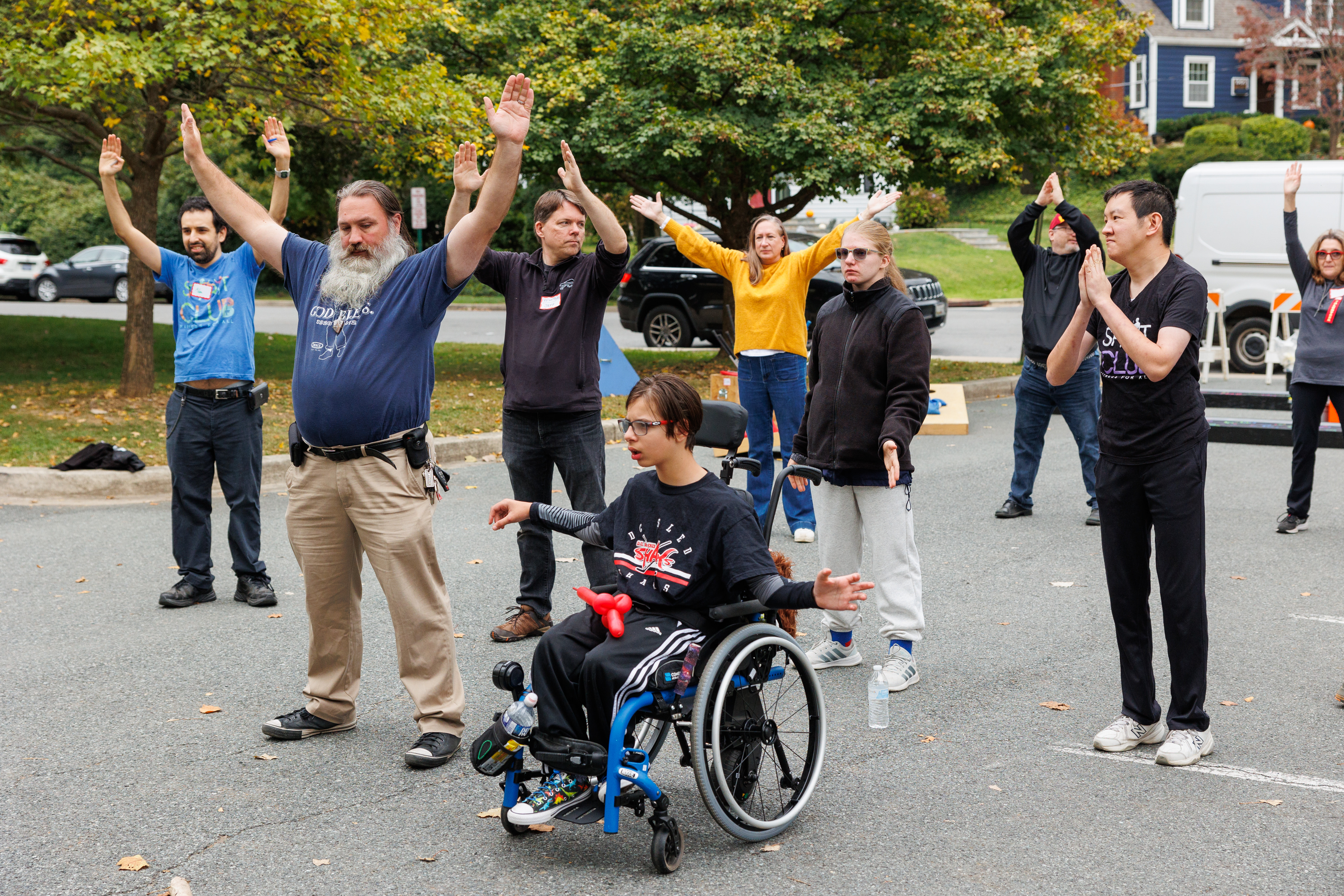Nonprofit organizations often set themselves apart by facilitating activities and events that meet the needs of the communities they serve. accessiBe is proud to partner with many incredible nonprofits like you, who improve the lives of people with disabilities. Many of our partners are changing the game for people with disabilities by providing opportunities for inclusive fitness.
Adaptive fitness is when exercise and sports are modified to include accessible equipment, inclusive environments, and training techniques that include people with disabilities.
We spoke with some of the most impactful nonprofits in the adaptive fitness world, who level the playing field for all types of athletes and organize fitness events for everyone. For nonprofits who want to set up adaptive fitness events for their own communities, here’s how you can get going and make a difference.
How to pitch adaptive fitness to the masses
Adaptive fitness needs to be promoted and publicized to capture the attention of athletes, of all abilities, who may want to participate in a sporting event or competition that piques their interest.
So, what kind of wisdom can you take from the pages of athletic-focused organizations to make adaptive fitness more popular and well-known in your area?
First, spread awareness within your communities by letting people know that you’re creating a safe and equitable environment for all athletes that is centered on teamwork and shared goals.
“Sports brings people together. It teaches us how to share, trust, and work as a team. These opportunities should be available to all, regardless of ability. Creating an environment that is equitable and safe for individuals with and without disabilities to work towards a common goal, is an excellent way to promote inclusion.” - Casey Vattimo, Senior Vice President, External Relations at Special Olympics New York
Next, put more effort into mixing people of varying abilities on one team and allow them to jog a mile in each other’s shoes. When people without disabilities have the chance to understand an athlete with a disability’s perspective, then they’ll be more likely to help spread awareness and push for adaptive fitness to be a priority among their own communities.
"As blind football Uganda, we always organize community matches where we allow the sighted people in the community to have a feel of how blind football is played which removes the disbelief that a blind person can`t play football or soccer. In these inclusive matches, all rules as applied to the blind players are used. We organize collective meals at all our matches and events which in the end promotes socialization for everyone to learn about one another's cultures, and backgrounds on the food tables Inclusive training sessions.” - Jagwe Muzafaru, Chairperson at Blind Football Uganda
Publicizing the importance and existence of adaptive fitness is just the beginning stage in setting up events or competitions in your area. But, as long as you create safe spaces and bring together athletes who play by the same inclusive rules, you’re off to a great start.
How to draft athletes into the big league
People with disabilities may be hesitant or reluctant to join in on an adaptive fitness event, but you can still successfully motivate more people with disabilities to become athletes. Many organizations currently excel at making new athletes feel relaxed and included in their adaptive fitness events, and here are some examples of how you can do it, too.
Always make sure your adaptive fitness event takes place in a safe and accessible environment. Safety precautions, especially, are a crucial aspect of any adaptive fitness event. Many nonprofits address the questions and concerns of people with disabilities who want to take part in a competition or event, and this makes them feel more comfortable when joining.

“Everyone is different, however, most of us have a little reluctance when trying something new for the first time. The team at Blue Ridge Adaptive Snow Sports and other adaptive programs recognize this and we take steps to make our students feel comfortable and let them know that we will progress with attention to their comfort level and safety.” - Steve Gurney, Board Member at Blue Ridge Adaptive Snow Sports
Never stop teaching athletes of any ability that they can do whatever they set their minds to. We all need to take advantage of any opportunity to support an athlete with a disability and assure them that they can score a touchdown, paddle back to shore, or set a new time record. This unwavering belief in their fitness abilities will motivate them to take part in your sporting event.
“Especially with water sports people and their families usually shoot low. We have to get people ‘out of their heads’ and show them how they can windsurf or paddle. Many ask to kayak without knowing we can have virtually anyone windsurf, for example. If we can, we like to urge people to try something new and surprise themselves.” - Ross Lilley, Executive Director at Access Sport America
It’s also just as equally important to supply the right equipment to athletes with disabilities so they can participate in a fitness event to the fullest extent possible. Accessible equipment ensures that any athlete with a disability can participate in a game that excites them, boosts their confidence, and contributes to the quality of performance.
“The accessibility of the exercise classes and facilities can greatly impact the willingness of individuals with disabilities to participate. If the classes are held in inclusive and accessible spaces, have appropriate equipment, and consider the specific needs of participants, it can increase the likelihood of positive engagement.” - Kim Schofield, Executive Director at Spirit Club Foundation
How teamwork makes the dream work
If you assemble a team of athletes with and without disabilities, you’re helping them come together and promoting inclusion at the core of your adaptive fitness event. And, as the nonprofit setting up an adaptive fitness event, this type of inclusion will only guarantee new connections and relationships among your athletes. A sense of community is more than enough to shine the spotlight on your adaptive fitness event that sets out to do some good.
“Creating classes that are integrated is very powerful as it allows people of different backgrounds and abilities to become connected through fitness. Most people think about the benefits this creates for people with disabilities to be included with the general population, however, the benefits go both ways. Providing an opportunity for people without disabilities to become involved in the lives of those with disabilities is of at least equal importance and value.” - Kim Schofield, Executive Director at Spirit Club Foundation

It’s just not about the game or the competition, though. If you combine training sessions, you can create comradery between athletes of different abilities. There are organizations out there that do this in an equitable manner that sustains the community connections they’ve helped build.
“Unified Sports combines athletes with and without intellectual disabilities on sports teams for training and competition. The program is dedicated to promoting social inclusion through shared sports training and competition experiences. It was inspired by a simple principle: training together and playing together is a quick path to friendship and understanding.” - Casey Vattimo, Senior Vice President, External Relations at Special Olympics New York
Sustaining these communities ensures that inclusive approaches to adaptive fitness are constantly implemented. For nonprofits new to the adaptive fitness game, it’s important not to forget to offer off-the-field opportunities, as well, and giving athletes with and without disabilities voices in other arenas will only prolong your adaptive sports initiatives and awareness.
“Ideally it is a team and there is no segregation. We work hard to include everyone's viewpoints and perspectives equally. We have several of our students who have become assistants, volunteers, and instructors over the years.” - Steve Gurney, Board Member at Blue Ridge Adaptive Snow Sports
How to broadcast important facts
People who aren’t interested in fitness or who don’t know enough about the disability communities may not even be aware that adaptive sports exist. Be sure to light the lamp on adaptive fitness and actively debunk stereotypes to continually prove the need for adaptive fitness in your community.
For example, did you know adaptive fitness and organized events contribute more to society than anyone actually realizes? Setting up adaptive fitness events in a specific community could have a massive impact on several economic issues, like unemployment, and can potentially increase tourist revenue for your hometown.
“Adaptive sports have the power to tackle social-economic difficulties in our societies like unemployment, inactivity, mental health, societal conflicts and so many others as a universal tool Adaptive sports promote inclusive tourism; This is evident in places where sports events and competitions are organized, athletes end up visiting tourists sites like lakes, rivers, game parks which persons with disabilities do not normally visit which help accommodate to make a considerable adjustment to their places through their reviews and policymakers in making these sites disability friendly.” - Jagwe Muzafaru, Chairperson at Blind Football Uganda
Adaptive sports are also a therapeutic tool for those who practice. Spread the word on its effect as a physical therapy tool that enhances the quality of life, and explain how it allows athletes with disabilities to show themselves and the world what they’re really capable of, despite common misconceptions.
“Adaptive sports provide such therapeutic recreation to individuals with disabilities and allow them to overcome their challenges.” - Jonathan Snyder, Executive Director and Adaptive Golfer at US Adaptive Golf Alliance
Hit a home run with adaptive fitness
By spreading awareness for accessible athletics, making room for people with and without disabilities on the same field, and supplying assistive equipment to athletes, your nonprofit can really make a difference and facilitate its own adaptive fitness events. By enabling training and competitions that give athletes with disabilities the outlet they need to play the sport they love, you’ll be doing more than just setting up a friendly match here and there. You’ll be creating communities built on common ground, improving the quality of life for certain players, and exposing adaptive fitness to more and more people who have been missing out on some great games!


